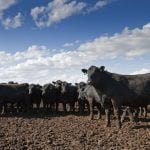
Tag Archives livestock feeding

Light barley: To buy or not to buy?
This year, crop yields in the Prairies have improved significantly compared to the last few years, thanks to increased rainfall in Western Canada. However, the dry and hot conditions in July and August negatively affected cereal grain quality in some areas. This weather occurred during a critical growth period for barley, specifically during the filling […] Read more

Creep feeding when fall calving
For producers who are fall calving, creep feeding might be a viable option to supplement the diet of nursing calves
For cattle producers who are fall calving, supplementing the calves’ diets is often important, given the state of forages at that time. This is where creep feeding comes into play. For some cattle producers, while their grain-producing neighbours are in the fields taking the crops off, they are walking on foot through their pastures, searching […] Read more

What to know about grazing cattle on crop stubble
What are the benefits and challenges of stubble grazing after harvest, to extend the grazing season?
When it comes to extending the grazing season, stubble grazing is a viable option for many producers on the Prairies. But what are the benefits, and what are the challenges that come with it? Grazing the stubble left after harvest has some real advantages. “The first thing it does is it provides additional forage that […] Read more

Changing feeding programs after calving
Nutrition with Barry Yaremcio
Cows and bred heifers require 25 per cent more nutrients after calving than during late pregnancy. Milk production peaks eight weeks after calving. Feed intake increases until 12 weeks after calving. The increased feed intake is the result of the digestive system expanding to fill the space that was occupied by the fetus and reproductive […] Read more

Grain overload in cattle
Vet Advice with Dr. Ron Clarke
Only a few calls in practice were totally disheartening. Grain overload in a group of pregnant brood cows three months from calving at -25 C turned out to be one of the worst. By the time producers noticed signs of grain engorgement, cows were often really sick: staggering, down and unable to rise, dehydrated, rumen […] Read more

Preparing cattle for the breeding season
Many factors influence the success of a breeding season. Bulls must be in good shape to perform. The body condition of pregnant and lactating animals greatly affects a cow or heifer’s ability to cycle and be receptive to a bull. It’s important to discuss vaccination and herd health programs, bull soundness and semen evaluation with […] Read more

Deer and elk take a bite out of winter feed
As Alberta’s wildlife populations balloon, who will pick up the dinner cheque becomes a pressing question for beef producers
Wildlife and livestock co-exist on pasture throughout the summer. However, in winter when livestock are being fed, wildlife can become a nuisance. Across Alberta, many producers are dealing with wildlife in winter feed, but how many are experiencing problems is not known. “It’s pretty ubiquitous throughout the province, but what changes is species,” says Mark […] Read more

Barley market update
Market Talk with Jerry Klassen
During the second week of October, southern Alberta feedlots were buying feed barley in the range of $330-$340/tonne delivered. In central Alberta, major operations were making purchases from $290-$335/tonne delivered. The barley harvest has wrapped up across Western Canada and producer selling appears to be easing. The market appears to be stabilizing at the current […] Read more

Demystifying near-infrared spectroscopy
Unpacking how this technology works and how it can used to analyze forage, feed and feces
The composition of feeds, forages and feces has traditionally been determined using wet chemistry methods, often referred to as the gold standard. However, the trade-off for this level of accuracy is often a high cost and a long turnaround time to perform the analysis. In that time, the nutrient profile of forages in grazing systems […] Read more

Researchers hope hybrid rye silage can help plug feed gap
With less ergot risk than conventional rye, hybrid rye may be a good option for some cattle feeders
Frank Zhang says when he talks to his colleagues about silage, they all are familiar with barley silage — but none are familiar with rye silage. “It’s very rare to find people using the rye silage,” Zhang says. “But thinking about the environment changing, just like the drought this year … this might provide an […] Read more



